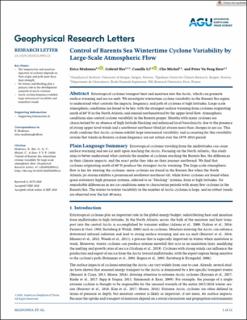Control of Barents Sea wintertime cyclone variability by large-scale atmospheric flow
Journal article, Peer reviewed
Published version

Åpne
Permanent lenke
https://hdl.handle.net/11250/2740321Utgivelsesdato
2020Metadata
Vis full innførselSamlinger
- Geophysical Institute [1228]
- Registrations from Cristin [10412]
Sammendrag
Extratropical cyclones transport heat and moisture into the Arctic, which can promote surface warming and sea ice melt. We investigate wintertime cyclone variability in the Barents Sea region to understand what controls the impacts, frequency, and path of cyclones at high latitudes. Large‐scale atmospheric conditions are found to be key, with the strongest surface warming from cyclones originating south of 60°N in the North Atlantic and steered northeastward by the upper‐level flow. Atmospheric conditions also control cyclone variability in the Barents proper: Months with many cyclones are characterized by an absence of high‐latitude blocking and enhanced local baroclinicity, due to the presence of strong upper‐level winds and a southwest‐northeast tilted jet stream more than changes in sea ice. This study confirms that Arctic cyclones exhibit large interannual variability, and accounting for this variability reveals that trends in Barents cyclone frequency are not robust over the 1979–2018 period.